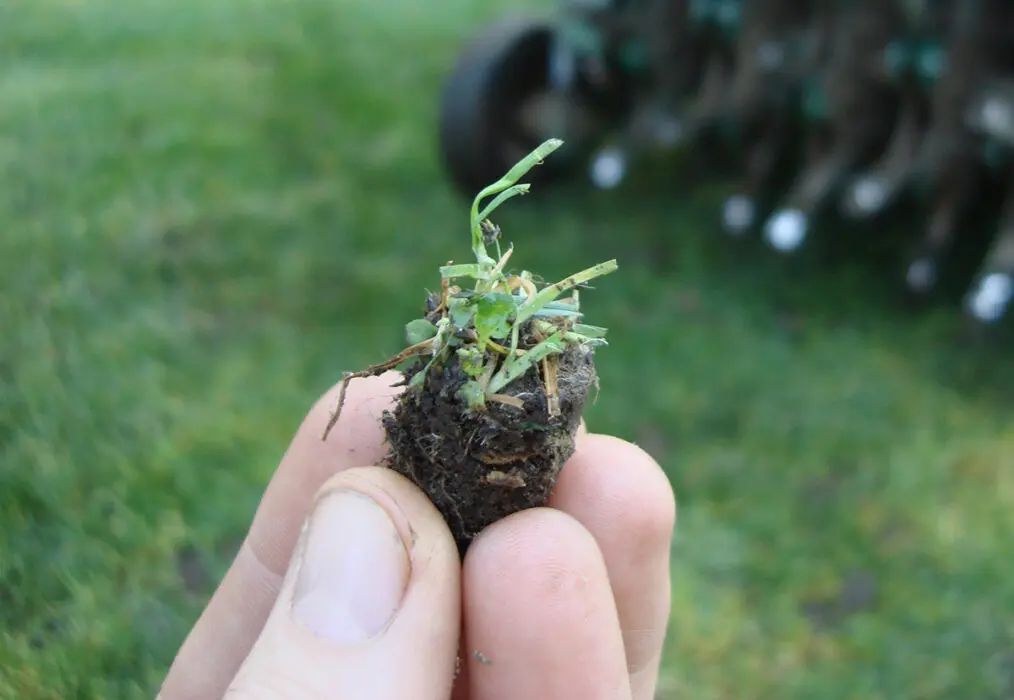
Lawn aeration involves creating holes in the soil, allowing air, water, and nutrients to penetrate more effectively to the grass roots for better growth. Aeration is one of the most effective ways to improve turf health and relieve compacted soil so you can maintain a healthy lawn. Timing is everything—knowing when to aerate ensures the best results. JHL Turf Pros shares expert insights on how and when to aerate your lawn for stronger, greener lawns year-round.
What Is Lawn Aeration and Why Does It Matter?
Soil compacts over time, especially in clay soil or areas with a lot of foot traffic. This makes it hard for roots to grow and limits how well plants can absorb nutrients. Lawn aeration involves putting small holes in the soil to allow air, water, and nutrients to penetrate deeply into the root zone.
Aeration improves drainage by loosening the soil. It helps reduce compaction and encourages stronger root growth. This process also makes your lawn more resistant to drought and disease. Lawns suffering from poor growth or patchy areas often benefit from aeration as part of a regular care routine.
Professional lawn care experts often use core aerators. These tools remove small plugs of soil and create deeper channels for nutrients and moisture. This proven method and the right aerator equipment deliver long-term improvement in soil and turf health.

Signs It’s Time to Aerate Your Lawn
If you see pooling water, thin grass, patchy grass, or hard soil, your lawn may have problems. It might be struggling with airflow and drainage.
Try the “screwdriver test.” Push a screwdriver into the ground. If it is hard to insert, soil compaction may be the issue.
Lawns exposed to high foot traffic, clay soil, or heavy thatch buildup need aeration more frequently to stay healthy. Compacted lawns can’t efficiently absorb nutrients or water, making it harder for grass to thrive. Spotting these signs early helps you find the best time to aerate. This leads to lasting results based on your soil type and site conditions.
When to Aerate Cool-Season Lawns
Cool-season grasses—such as Kentucky bluegrass, fescue, and ryegrass—grow most actively in early spring and early fall. The best time to aerate is early fall. During this time, temperatures are mild and the soil holds moisture. This creates a great environment for recovery and growth.
Aerating during this period allows grass roots to expand before winter dormancy, improving strength and density. Pair aeration with overseeding to fill in bare spots and encourage a thicker lawn. When cool season grasses are actively growing, aeration supports deep root development and healthier turf throughout the year, across different grass types.
How to Aerate Your Lawn
Core aeration and spike aeration are the two main aeration methods. Core aeration—preferred by professionals—removes small plugs of soil to relieve soil compaction and improve nutrient absorption. Spike aeration, which simply pokes holes, offers less long-term benefit.
Before starting, water your lawn about 24 hours in advance to soften the soil, but avoid soggy conditions. Overlap your passes with the aerator, focusing on compacted zones for the best coverage. Use appropriate aerator equipment for your lawn size and conditions.
After aeration, leave the plugs on the surface to decompose naturally, returning nutrients to the soil. These cores will break down and help reduce compaction and reach the root zone. Finish by applying grass seed and fertilizer to help new growth thrive and ensure better air, water, and nutrient flow. If desired, lightly rake to distribute cores rather than remove plugs.
Common Aeration Mistakes to Avoid
Timing and conditions are key. Never aerate when your lawn is dormant or during extreme heat or cold—it can cause stress and damage roots. Avoid aerating overly dry soil, as it won’t allow the tines to penetrate deeply enough.
Over-aerating can also thin your turf and expose roots. Always aerate when the grass is growing. This helps your lawn get better soil structure and absorb nutrients at the right time. Consider soil type and site traffic to set the right frequency.
When to Call Lawn Care Experts
For large yards or lawns with severe soil compaction, professional help is best. Lawn care experts like JHL Turf Pros use commercial-grade core aerators designed to reach optimal depth and provide consistent coverage. They know when to remove plugs efficiently and how to set the machine depth for your property.
Professionals can also evaluate your clay soil conditions and recommend an aeration service schedule tailored to your property. Their expertise ensures your lawn gets the maximum benefit from aeration without unnecessary stress or damage.

Trust JHL Turf Pros for a Healthier Lawn
JHL Turf Pros knows Pennsylvania’s special climate and soil. They create custom aeration plans for cool and warm season grasses. This ensures your turf gets what it needs to grow well. From selecting the right aerator equipment to timing services for your grass types, we focus on practices that reduce compaction and promote a healthy lawn.
If your lawn has problems like compaction, poor drainage, or thin growth, JHL Turf Pros can help. Our lawn care experts will make your yard stronger, greener, and more resilient all year long.
Request a Lawn Evaluation Today
Contact the lawn care experts at JHL Turf Pros for a professional evaluation. They’ll assess your soil, determine the right time to aerate, and recommend a plan to keep your lawn looking its best.
Request a free quote or schedule an aeration service today.
